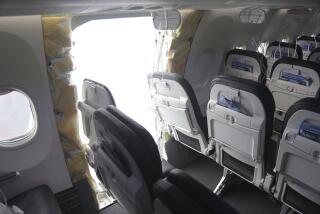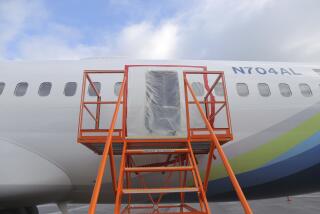NASA to Study Tail Fin From Jet Crash
- Share via
WASHINGTON — Federal air safety investigators said Thursday that they will ask NASA for help in determining why the tail fin of American Airlines Flight 587 broke off, an unusual step that underscores the difficulty of the probe.
The National Transportation Safety Board said it will ship the Airbus A300’s vertical tail fin and rudder to NASA’s Langley Research Center in Hampton, Va., for testing. Langley is the space agency’s lead center for developing advanced materials like the carbon fiber composite from which the 27-foot tail fin was constructed. The analysis could take several months.
Composites are increasingly taking the place of metal on all types of aircraft, from stealth fighters to corporate jets to commercial airliners. They are stronger and lighter than most metals, and their use is likely to keep growing. But composites also are raising a new set of safety questions.
“This is the first accident we have investigated where a major structural component built with composites has failed, and we are trying to find out why that happened,” said Ted Lopatkiewicz, an NTSB spokesman.
Flight 587 crashed Nov. 12 shortly after taking off from John F. Kennedy International Airport in New York, killing all 260 people aboard and another five on the ground. The tail fin was found in Jamaica Bay, about a half mile from the Queens neighborhood where the main fuselage crashed.
The NTSB is world-renowned for its expertise in metal failures, but the agency’s scientists don’t have much experience with composites. Those materials are made of many layers of carbon fibers embedded in a special epoxy resin and molded together under heat and pressure. Unlike metals, composites are largely immune to corrosion.
However, composites can develop internal flaws that cause the layers to come apart, particularly if damaged by some kind of impact.
NTSB officials say they have been unable so far to determine what initial event led to the failure of the tail fin. The plane encountered turbulence from another aircraft ahead of it. The flight data recorder also registered several movements of the plane’s rudder, which is attached to the tail fin. But aviation experts say none of those events should have caused the fin to fall off.
Scientists at Langley will be able to use specialized imaging technology to inspect the interior of the tail fin for possible damage. They will also evaluate the design and overall strength of the structure, to see if it was adequate to begin with. And they will be able to use computer modeling to attempt to re-create what may have happened in the crash.
Ever Barbero, an engineering professor at West Virginia University who has written a textbook on composite materials, said the scientists will not have an easy job.
“When a part breaks, a lot of energy is released, and there is a lot of collateral damage,” Barbero said. “You cannot always tell if you are looking at damage that was there before, or damage that occurred during the event. New damage can mask any old damage.”
Investigators are trying to determine whether a repair to the tail fin when the aircraft was first delivered in 1988 could have been a factor in the accident. So far they have reached no conclusions.
NTSB officials previously said the repair involved one of six attachment fittings that connected the tail fin to the main fuselage. At the time, inspectors found that some of the layers of the composite material in the left center fitting were coming apart. A special resin was injected into the area and the fitting was thickened and strengthened with rivets.
Barbero questioned why the entire tail fin was not replaced then.
“There are standards for repair, but usually you do not repair a new aircraft,” Barbero said. “Usually you repair a part because it was damaged in service. Let’s say you buy a new car and you take it home and you discover rust on the door. You take it back to the dealer and he offers to repaint the door. Would you accept that? You would want a new door.”
Airbus and American Airlines have declined to comment on what may have caused the crash, citing the NTSB’s investigation. But an industry official said it is not unusual for a new aircraft to have some component repaired before it is put into service.
More to Read
Inside the business of entertainment
The Wide Shot brings you news, analysis and insights on everything from streaming wars to production — and what it all means for the future.
You may occasionally receive promotional content from the Los Angeles Times.










